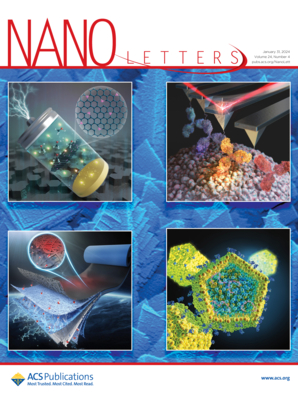Chemical Doping Reveals Band-like Charge Transport at Grain Boundaries in Organic Transistors
IF 9.6
1区 材料科学
Q1 CHEMISTRY, MULTIDISCIPLINARY
引用次数: 0
Abstract
Organic semiconductors are highly promising as channel materials for energy-efficient, cost-effective, and flexible electronics. However, grain boundaries (GBs) can cause significant device performance variation, posing a major challenge for the development of high-performance organic circuits. In this work, we effectively passivated GB-induced traps in monolayer organic thin-film transistors (OTFTs) via p-type doping with the organic salt TrTPFB. The doping strategy broadens the mobility edge, effectively shielding GB-induced energy barriers and Coulomb scattering, and promotes deeper nonlocalized hybridization states for conduction. Consequently, the charge transport mechanism transitions from multiple trapping and release (MTR) to a more band-like behavior, even when GBs are present within the device channel. The doped OTFTs demonstrate ultralow mobility variation (1.4%) and threshold voltage variation (4.9%), as well as record-low contact resistant of RC = 0.6 Ω·cm, outperforming most single-crystal technologies. These performance metrics render doped monolayer polycrystalline films highly promising candidates for industrial-scale organic electronics.

求助全文
约1分钟内获得全文
求助全文
来源期刊

Nano Letters
工程技术-材料科学:综合
CiteScore
16.80
自引率
2.80%
发文量
1182
审稿时长
1.4 months
期刊介绍:
Nano Letters serves as a dynamic platform for promptly disseminating original results in fundamental, applied, and emerging research across all facets of nanoscience and nanotechnology. A pivotal criterion for inclusion within Nano Letters is the convergence of at least two different areas or disciplines, ensuring a rich interdisciplinary scope. The journal is dedicated to fostering exploration in diverse areas, including:
- Experimental and theoretical findings on physical, chemical, and biological phenomena at the nanoscale
- Synthesis, characterization, and processing of organic, inorganic, polymer, and hybrid nanomaterials through physical, chemical, and biological methodologies
- Modeling and simulation of synthetic, assembly, and interaction processes
- Realization of integrated nanostructures and nano-engineered devices exhibiting advanced performance
- Applications of nanoscale materials in living and environmental systems
Nano Letters is committed to advancing and showcasing groundbreaking research that intersects various domains, fostering innovation and collaboration in the ever-evolving field of nanoscience and nanotechnology.
 求助内容:
求助内容: 应助结果提醒方式:
应助结果提醒方式:


